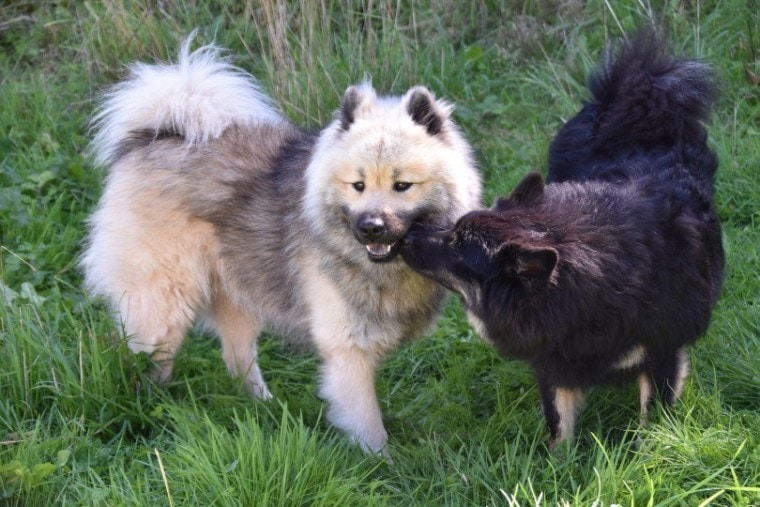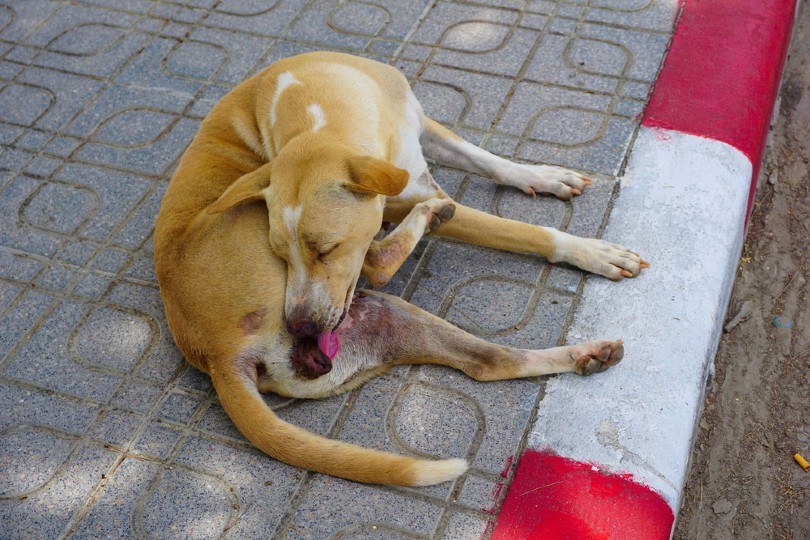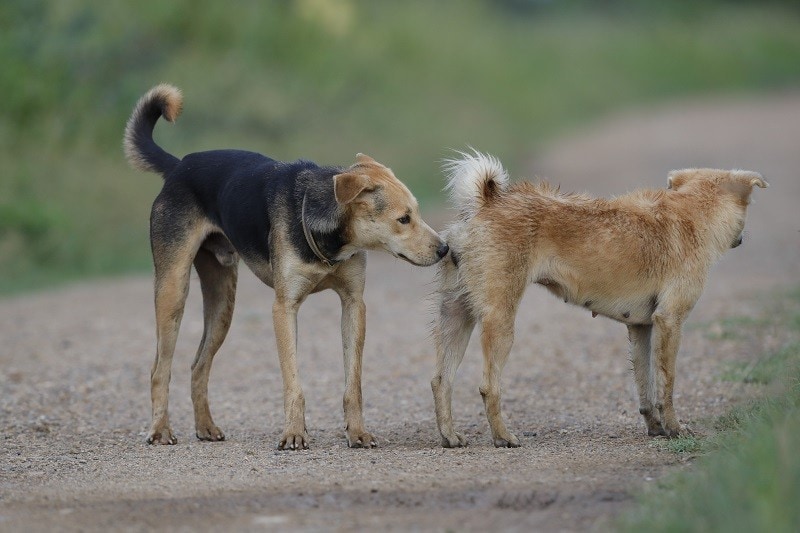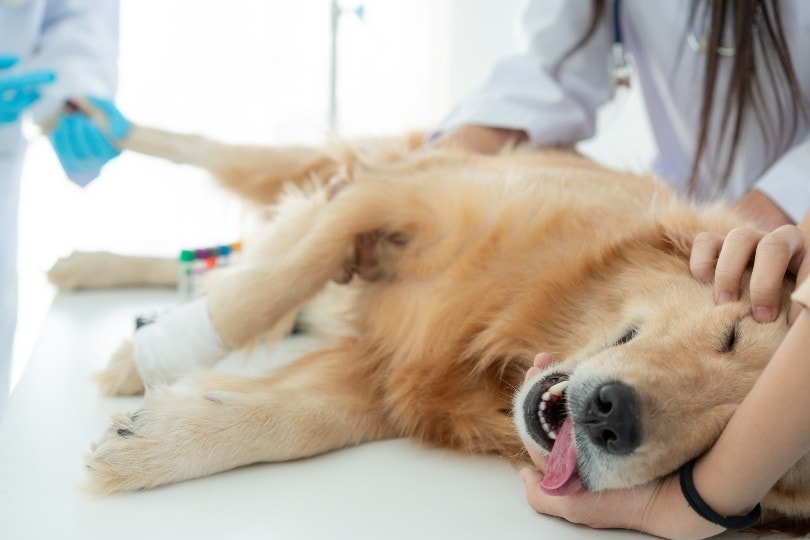Physical Signs of Proestrus and Estrus in Dogs (Updated in 2022)

Whether you want to breed your female dog or are anxious to get her spayed before she undergoes her first heat cycle, knowing the physical signs indicating the start of the heat process is essential. The canine reproductive cycle is divided into four parts: proestrus, estrus, diestrus, and anestrus. Proestrus and estrus are the two parts that occur when the dog is considered to be “in heat.”
The main physical signs of starting proestrus are swelling of the dog’s vulva and bloody discharge. The main physical signs that the dog has progressed into estrus include a wrinkled vulva, caused by a rapid decrease in swelling, and the discharge becoming thinner or brownish in color.

What Happens During Proestrus and Estrus?
Proestrus and estrus occur when your female dog’s body is preparing for possible breeding and pregnancy. Most dogs will go into heat about every 6 months, although there is some size and breed variation. Female puppies usually experience their first heat around 6 months of age, but it can happen anywhere between 4 and 24 months. Besides the physical signs already mentioned, most dogs will undergo some behavioral changes during proestrus and estrus.
Proestrus

Proestrus is the first stage of the dog’s heat cycle. In the days leading up to the start of proestrus, you may notice your dog seems nervous, more tired than usual, or maybe she is eating less. Proestrus starts when her vulva swells up and a bloody discharge begins. Around this time, you may also start to notice male dogs taking an interest in your female. She will most likely first be aggressive and then indifferent to male dogs as she progresses further into her proestrus. Proestrus usually lasts around 9 days, but the length can be anywhere from 3-17 days.
Estrus
Estrus is the stage of the cycle when your female is ready and usually willing to breed. You will notice that your dog’s vulva becomes smaller, softer, and wrinkled as she moves into estrus. Her discharge will become less bloody. Behaviorally, you may notice that she is now interested in male dogs rather than aggressive towards them. She may carry her tail up or to the side, a behavior known as flagging. Estrus can last from 3-18 days, with around 9 days being the average.
What About the Other Phases of The Reproductive Cycle?
The two final phases of a dog’s reproductive cycle are diestrus and anestrus.
Diestrus occurs after estrus and usually lasts about 2 months. During this stage, your dog’s hormone levels are changing. You will likely not notice any physical changes in your dog unless she has become pregnant.
Anestrus is the final phase of the cycle, which usually lasts around 4 months, but can be longer. During this phase, your dog will not exhibit any physical signs but internally her body is preparing for the start of the next proestrus.
Your Dog Is In Heat: Now What?

You’ve learned what the physical signs of proestrus and estrus are and, sure enough, now you’ve noticed them in your dog. What should you do?
If you are not planning to breed your dog, make sure no unneutered male dogs can get near her during estrus. This includes any male dogs that are related to her.
Keep your female leashed during walks and only let her out into a fenced area. You will still need to supervise her when she’s outside. Male dogs are notoriously persistent in the presence of a female in heat so be sure to be extremely vigilant to prevent accidental breeding.
If a male dog does get to your female despite your watchfulness, contact your veterinarian to learn what your options are to prevent pregnancy.
Proestrus and estrus can cause quite a mess due to the bloody discharge. To try and contain the mess, you may choose to keep your dog in a crate or easy to clean room while she’s in heat. If she tolerates it, you can also have your dog wear a dog diaper during her proestrus and estrus. Dog wipes can be useful in keeping your dog clean as well.
If you plan to breed your dog, make sure you thoroughly research everything that goes into being responsible before you commit to the process. Responsible dog breeding is a time-consuming and often expensive undertaking. Pet overpopulation is a huge concern, so make sure you are breeding your dog for the right reasons and that you do it properly.
You Don’t Want To Deal With A Dog In Heat: Now What?

If you don’t want to breed your dog and you think that dealing with a dog in heat sounds like a hassle, the best thing to do is have your dog spayed, or “fixed.” Besides being more convenient, there are several other reasons it’s a good idea to spay your dog.
Spaying your dog before she first goes into heat will almost eliminate the chance that she gets mammary (breast) cancer. This type of cancer can be painful and hard to treat so avoiding it altogether is the best way to go.
Unspayed female dogs can also develop a serious infection in their uterus called pyometra. Pyometra can make your dog very sick and will kill her if not treated. Spaying your dog will keep her from developing this life-threatening condition.
As already mentioned, pet overpopulation is a serious issue in many parts of the world. By spaying your dog, you make certain that she won’t be contributing to that problem. Spaying your dog is not only beneficial for her and convenient for you but helps make a difference in the lives of homeless dogs as well.
If you are ready to spay your dog, your veterinarian will be able to give you more information on the process and what to expect as your dog recovers.

Conclusion
Knowing the physical signs of proestrus and estrus will help you be aware of when your dog’s heat cycle begins. This knowledge will help you prepare to manage your dog during her heat period. Of course, you want your dog to be as safe, clean, and comfortable as possible while she experiences this process. Educating yourself is an important part of being a responsible pet parent and you are doing your part!
We can link to one of our recently written articles on becoming a breeder.
Featured Image Credit: JackieLou DL, Pixabay



Không có nhận xét nào